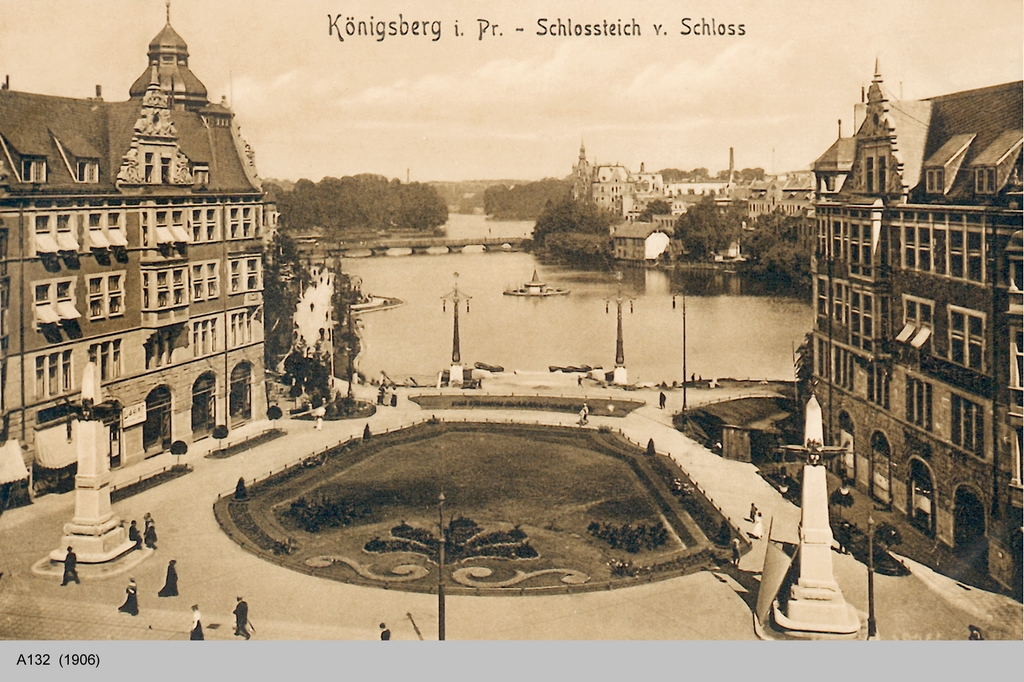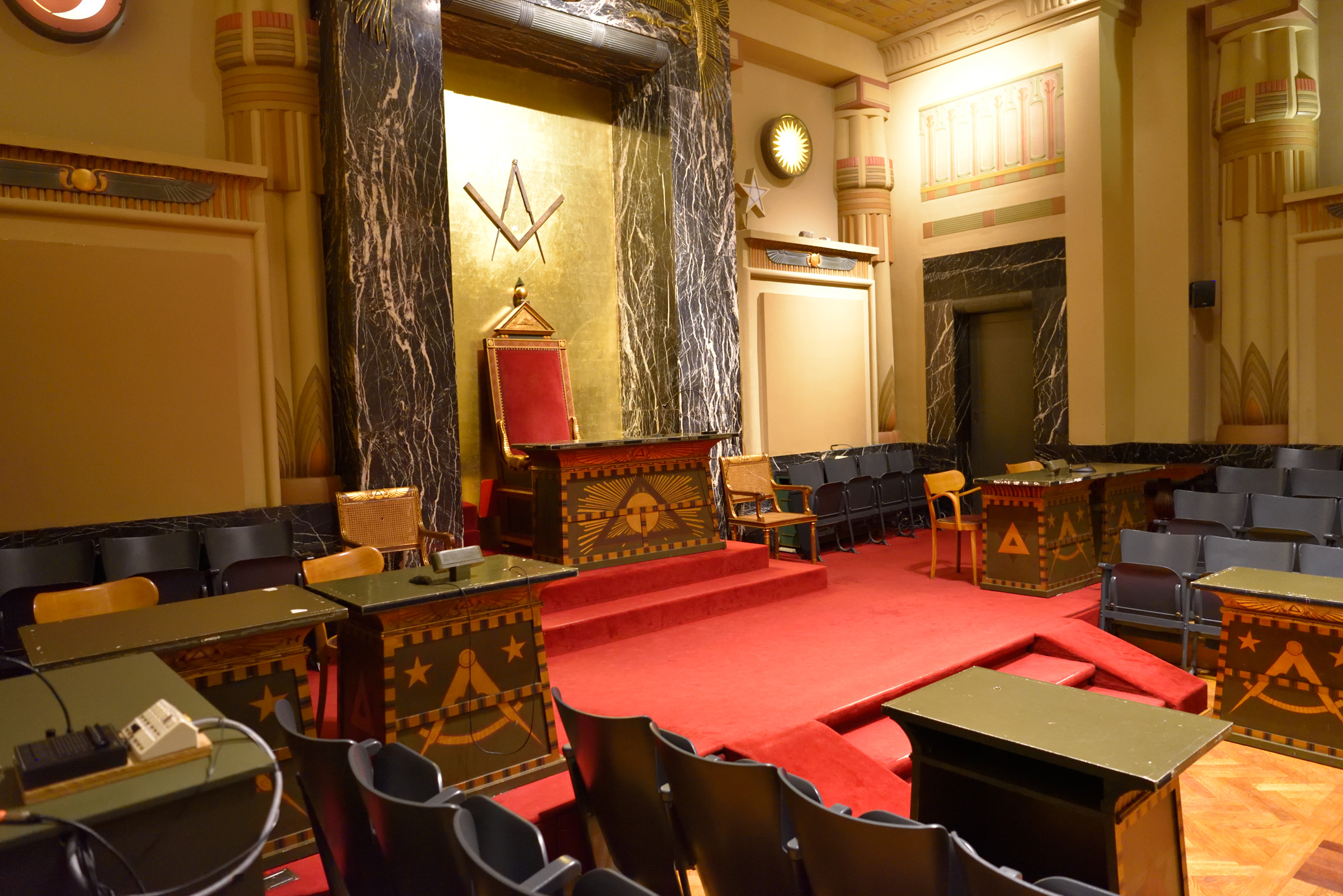|
Lower Pond (Kaliningrad)
The Lower Pond (russian: Нижний пруд) is a large artificial pond in northern Kaliningrad, Russia. It was known as the Schlossteich while part of Königsberg, Germany, until 1945. The pond is about one kilometre long, north to south. Along its length, its width varies between about 50 and 100 metres. The source of the water is from the north. The water eventually drains underground down to the river Pregel to the south. During the winter months, the pond can freeze over. History The pond, first documented by the Teutonic Knights in 1256, was created by damming the Katzbach stream which led to the Pregel.Albinus, p. 276 Mills constructed nearby caused the pond to be known as the Mühlenteich (mill pond). The Teutonic Knights' infirmary was constructed along the southwestern edge of the pond, while the Magdalenenkloster (Magdalene monastery) was built on the southern shore. A second pond, the Oberteich or Upper Pond, was created north of the first pond in 1270. B ... [...More Info...] [...Related Items...] OR: [Wikipedia] [Google] [Baidu] |
Kaliningrad
Kaliningrad ( ; rus, Калининград, p=kəlʲɪnʲɪnˈɡrat, links=y), until 1946 known as Königsberg (; rus, Кёнигсберг, Kyonigsberg, ˈkʲɵnʲɪɡzbɛrk; rus, Короле́вец, Korolevets), is the largest city and administrative centre of Kaliningrad Oblast, a Russian semi-exclave between Lithuania and Poland. The city sits about west from mainland Russia. The city is situated on the Pregolya River, at the head of the Vistula Lagoon on the Baltic Sea, and is the only ice-free port of Russia and the Baltic states on the Baltic Sea. Its population in 2020 was 489,359, with up to 800,000 residents in the urban agglomeration. Kaliningrad is the second-largest city in the Northwestern Federal District, after Saint Petersburg, the third-largest city in the Baltic region, and the seventh-largest city on the Baltic Sea. The settlement of modern-day Kaliningrad was founded in 1255 on the site of the ancient Old Prussian settlement ''Twangste'' by th ... [...More Info...] [...Related Items...] OR: [Wikipedia] [Google] [Baidu] |
Burgkirche (Königsberg)
The Burgkirche was a Reformed Protestant church of the Prussian Union in Königsberg, Prussia. History After the conversion of the Hohenzollern elector John Sigismund of Brandenburg, also Duke of Prussia from 1612, the first Calvinist service was performed in 1616 by the Hessian court chaplain Johannes Crocius in a hall of Königsberg Castle. In 1662 the 'Great Elector' Frederick William ordered the building of a new Reformed church and Latin school in the Burgfreiheit quarter near the castle, granting land near a slaughterhouse. The transfer of land only occurred in 1665, however, and the initiative was halted until the 1680s. In 1687 the court expanded the grounds for the church by purchasing a garden on the Schlossteich pond north of the former slaughterhouse from Oberburggraf Ahasverus von Lehndorff. The new Baroque church was built from 1690–96; Johann Arnold Nering modeled it after the sober appearance of the Nieuwe Kerk in The Hague. It was dedicated in the ... [...More Info...] [...Related Items...] OR: [Wikipedia] [Google] [Baidu] |
Paper Lantern
A paper lantern is a lantern made of thin, brightly colored paper. Paper lanterns come in various shapes and sizes, as well as various methods of construction. In their simplest form, they are simply a paper bag with a candle placed inside, although more complicated lanterns consist of a collapsible bamboo or metal frame of hoops covered with tough paper. Origin Paper lanterns are likely derived from earlier lanterns that used other types of translucent material like silk, horn, or animal skin. The material covering was used to prevent the flame in the lantern from being extinguished by wind, while still retaining its use as a light source. Papermaking technology originated from China from at least AD 105 during the Eastern Han Dynasty, but it is unknown exactly when paper became used for lanterns. Poems about paper lanterns start to appear in Chinese history at around the 6th century. Paper lanterns were common by the Tang Dynasty (AD 690–705), and it was during this period ... [...More Info...] [...Related Items...] OR: [Wikipedia] [Google] [Baidu] |
German Student Corps
Corps (or Korps; "''das ~''" ('' n''), (''sg.''), (''pl.'')) are the oldest still-existing kind of ''Studentenverbindung'', Germany's traditional university corporations; their roots date back to the 15th century. The oldest corps still existing today was founded in 1789. Its members are referred to as corps students (''Corpsstudenten''). The corps belong to the tradition of student fraternities which wear couleur and practice academic fencing. The corps are organized in two federations, the ''Kösener Senioren-Convents-Verband'' (''KSCV'') and the ''Weinheimer Senioren-Convent'' (''WSC''). Together, they comprise 162 Corps throughout Germany, Austria, Belgium, Estonia, Latvia, Hungary, Switzerland and Lithuania. The German Student Corps were traditionally recruited from the nobility, royalty, and social elite, and are traditionally viewed as more aristocratic and elitist than other German student fraternities such as the Catholic Cartellverband and the Burschenschaften. T ... [...More Info...] [...Related Items...] OR: [Wikipedia] [Google] [Baidu] |
Walpurgis Night
Walpurgis Night (), an abbreviation of Saint Walpurgis Night (from the German ), also known as Saint Walpurga's Eve (alternatively spelled Saint Walburga's Eve), is the eve of the Christian feast day of Saint Walpurga, an 8th-century abbess in Francia, and is celebrated on the night of 30 April and the day of 1 May. This feast commemorates the canonization of Saint Walpurga and the movement of her relics to Eichstätt, both of which occurred on 1 May 870. Saint Walpurga was hailed by the Christians of Germany for battling "pest, rabies, and whooping cough, as well as against witchcraft". Christians prayed to God through the intercession of Saint Walpurga in order to protect themselves from witchcraft, as Saint Walpurga was successful in converting the local populace to Christianity. In parts of Europe, people continue to light bonfires on Saint Walpurga's Eve in order to ward off evil spirits and witches. Others have historically made Christian pilgrimages to Saint Walburga's ... [...More Info...] [...Related Items...] OR: [Wikipedia] [Google] [Baidu] |
Kaliningrad Regional Museum Of History And Arts
The Kaliningrad Regional Museum of History and Arts (russian: Калининградский областной историко-художественный музей) is a museum along the Lower Pond in Kaliningrad, Russia. The building was built in 1912 by Berlin architect, Richard Zeil, originally the city hall (Stadthalle) and also a performing arts center in Königsberg, Germany. History Stadthalle in Königsberg The Stadthalle was planned by Oberbürgermeister Siegfried Körte in 1907 and opened in the Vorder-Roßgarten district in 1912 according to designs by Richard Seel. It included concert halls (Körtesaal, Krohnesaal, and Gebauhrsaal), a restaurant, and a garden cafe in front of the castle pond ''Schlossteich''. The halls were named after the initiators: Siegfried Körte, Theodor Krohne and Carl Julius Gebauhr. The Königsberger Philharmonie often performed in the 1,600-seat center. World War II The Stadthalle was used as a military hospital duri ... [...More Info...] [...Related Items...] OR: [Wikipedia] [Google] [Baidu] |
University Of Königsberg
The University of Königsberg (german: Albertus-Universität Königsberg) was the university of Königsberg in East Prussia. It was founded in 1544 as the world's second Protestant academy (after the University of Marburg) by Duke Albert of Prussia, and was commonly known as the Albertina. Following World War II, the city of Königsberg was transferred to the Soviet Union according to the 1945 Potsdam Agreement, and renamed Kaliningrad in 1946. The Albertina was closed and the remaining non-Lithuanian population either executed or expelled, by the terms of the Potsdam Agreement. Today, the Immanuel Kant Baltic Federal University in Kaliningrad claims to maintain the traditions of the Albertina. History Albert, former Grand Master of the Teutonic Knights and first Duke of Prussia since 1525, had purchased a piece of land behind Königsberg Cathedral on the Kneiphof island of the Pregel River from the Samland chapter, where he had an academic gymnasium (school) erected in 154 ... [...More Info...] [...Related Items...] OR: [Wikipedia] [Google] [Baidu] |
Schlossteich Königsberg
The Lower Pond (russian: Нижний пруд) is a large artificial pond in northern Kaliningrad, Russia. It was known as the Schlossteich while part of Königsberg, Germany, until 1945. The pond is about one kilometre long, north to south. Along its length, its width varies between about 50 and 100 metres. The source of the water is from the north. The water eventually drains underground down to the river Pregel to the south. During the winter months, the pond can freeze over. History The pond, first documented by the Teutonic Knights in 1256, was created by damming the Katzbach stream which led to the Pregel.Albinus, p. 276 Mills constructed nearby caused the pond to be known as the Mühlenteich (mill pond). The Teutonic Knights' infirmary was constructed along the southwestern edge of the pond, while the Magdalenenkloster (Magdalene monastery) was built on the southern shore. A second pond, the Oberteich or Upper Pond, was created north of the first pond in 1270. B ... [...More Info...] [...Related Items...] OR: [Wikipedia] [Google] [Baidu] |
Frederick William III Of Prussia
Frederick William III (german: Friedrich Wilhelm III.; 3 August 1770 – 7 June 1840) was King of Prussia from 16 November 1797 until his death in 1840. He was concurrently Elector of Brandenburg in the Holy Roman Empire until 6 August 1806, when the Empire was dissolved. Frederick William III ruled Prussia during the difficult times of the Napoleonic Wars. The king reluctantly joined the coalition against Napoleon in the . Following Napoleon's defeat, he took part in the Congress of Vienna, which assembled to settle the political questions arising from the new, post-Napoleonic order in Europe. His primary interests were internal – the reform of Prussia's Protestant churches. He was determined to unify the Protestant churches to homogenize their liturgy, organization, and architecture. The long-term goal was to have fully centralized royal control of all the Protestant churches in the Prussian Union of Churches. The king was said to be extremely shy and indecisive. His wife ... [...More Info...] [...Related Items...] OR: [Wikipedia] [Google] [Baidu] |
Masonic Lodge
A Masonic lodge, often termed a private lodge or constituent lodge, is the basic organisational unit of Freemasonry. It is also commonly used as a term for a building in which such a unit meets. Every new lodge must be warranted or chartered by a Grand Lodge, but is subject to its direction only in enforcing the published constitution of the jurisdiction. By exception the three surviving lodges that formed the world's first known grand lodge in London (now merged into the United Grand Lodge of England) have the unique privilege to operate as ''time immemorial'', i.e., without such warrant; only one other lodge operates without a warrant – the Grand Stewards' Lodge in London, although it is not also entitled to the "time immemorial" title. A Freemason is generally entitled to visit any lodge in any jurisdiction (i.e., under any Grand Lodge) in amity with his own. In some jurisdictions this privilege is restricted to Master Masons (that is, Freemasons who have attained the ... [...More Info...] [...Related Items...] OR: [Wikipedia] [Google] [Baidu] |
Kommandantur Königsberg
This is a list of words, terms, concepts and slogans of Nazi Germany used in the historiography covering the Nazi regime. Some words were coined by Adolf Hitler and other Nazi Party members. Other words and concepts were borrowed and appropriated, and other terms were already in use during the Weimar Republic. Finally, some are taken from Germany's cultural tradition. 0–9 * 25-point programme – The Nazi Party platform and a codification of its ideology. A * ''Abbeförderung'' ('dispatching, removal') – euphemism for killing. * ''abgeräumt'' ('cleared away') – slang expression for "murdered". * ''Abhörverbrecher'' ('wiretapping criminal') – Germans and others in the occupied countries who illegally listened to foreign news broadcasts. * ''Abkindern'' – an ironically intended colloquial designation for the cancellation of a marriage loan through the production of offspring. In German, ''ab'' means "off" and ''Kind'' means "child". * ''Ablieferungspflicht'' ... [...More Info...] [...Related Items...] OR: [Wikipedia] [Google] [Baidu] |




.jpg)


_crop.jpg)
